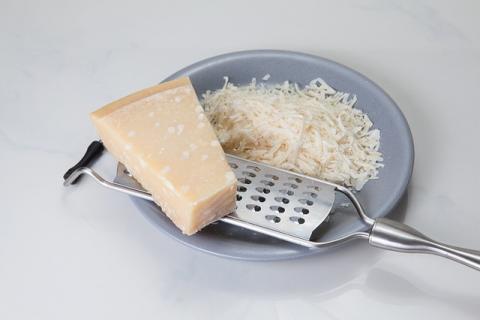
Living in France, I am tempted by cheese all the time. Famous for beautiful ash-rubbed rounds of chévre and silky soft “moelleux” wedges of Camembert, one wonders how the French manage not to overindulge. One secret in French culture is the cheese course of a meal traditionally follows the “plat,” or main plate, and after one has (hopefully) already filled up on protein and vegetables. Another secret here on the French Riviera, near the Italian border, is parmigiano reggiano, a staple in Italian cuisine.
In Italy, the geographically-based name for parmigiano reggiano is tightly controlled by the DOP (“Denominazione d’Origine Protetta,” or “Protected Designation of Origin”). Just like the AOP in France controls regional French products (see here for more details), the DOP protects and enforces the process and ingredients in parmigiano reggiano that make it both beneficial to one’s health and to the local region. Comparable protective agencies do not exist in the U.S., so it can be a bit more challenging to find true parmesan at your local grocery store; a pre-packaged cheese product that has a parmesan flavor can easily be labeled as “Parmesan.” Check at your local co-op or specialized food store for authentic parmigiano reggiano with the DOP label. You may pay a bit more for real, imported parmesan, but the health benefits of authentic parmesan are worth the extra penny.
But why go to all that trouble to find real parmigiano reggiano? Parmesan cheese (the real kind) is lactose-free, and relative to other cheeses, contains proportionally more protein and calcium and less fat (approximately 28%) because it is partially made with skimmed milk from locally grazed cows. Here are five reasons why parmigiano reggiano is my preference in the kapha season according to the Ayurvedic doshas:
1.Parmesan is easily digestible.
In the first 6-8 hours after parmesan is made, enzymes in the cheese transform the existing lactose into easy-to digest lactic acid. In the winter especially, eating foods that are easier to digest allows the body to save energy for other systems, like the immune system. (It is this trait that makes parmesan accessible to lactose-sensitive folks and/or those with gastro-intestinal sensitivities.)
2.Parmesan promotes gut health.
As it moves through the digestive tract, this nutrient-rich cheese encourages the development of Bacillus bifidus, which is a probiotic commonly present in fermented dairy products. It’s easy to digest and also supports healthy gut flora -- a function that typically shifts -- and struggles -- in the winter.
3.Parmesan is rich in protein and calcium.
While the water content in parmesan has been decreased by approximately 30%, protein composes about 33% of the cheese’s mass. Just over 3 tablespoons of parmesan cheese provides 75% of an adult’s recommended daily calcium intake and the cheese is also rich in minerals such as phosphorus, sodium and chloride and the trace elements selenium and zinc.
**Disclaimer: Eat parmesan in moderation! Parmesan contains on average 650mg of sodium per 100g (which is about 7 tablespoons); 1500mg of sodium is the recommended daily intake.
4.(Real) Parmesan contains no additives.
The production of parmesan cheese is strictly controlled by the Italian DOP, which does not permit additives in true parmigiano reggiano. With an aging process of 12-24 months, the cheese should not need additives if it is made and preserved properly.
5.Parmesan adds rich and wholesome flavor!
A little parmesan goes a long way, and it doesn’t take much to perk up a kapha-balancing meal. I love a sprinkle of parmesan on a fried egg, always in a warm grain salad, in winter squash soups, and of course on a hot pasta dish!








